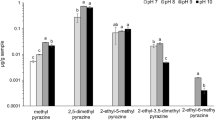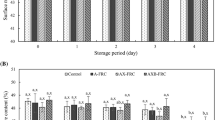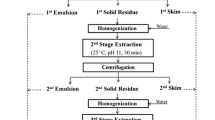Abstract
Various enzymes were used to treat a protein-enriched rice flour for the production of rice protein isolates. The rice flour containing 49% protein was a by-product from the processing of brown rice for syrup production. The treatment sequence of α-amylase followed by glucoamylase was most effective, resulting in a product with 85% protein content. The product was then treated with a mixture of cellulase and xylanase, which raised the protein content in the insoluble fraction to 91%. Inorganic impurities, such as the metal manganese in the starting rice flour, were effectively removed. The recovered rice proteins, practically intact according to electrophoretic analysis, had relatively poor solubility and emulsification properties; however, these functional properties were improved substantially by adding xanthan gum as a functionality-enhancing agent.
Similar content being viewed by others
References
Cagampang, G.B., L.J. Cruz, S.G. Espiritu, R.G. Santiago, and B.O. Juliano, Studies on the Extraction and Composition of Rice Proteins, Cereal Chem., 43:145–155 (1966).
Morita, T. and S. Kiriyama, Mass Production Method for Rice Protein Isolate and Nutritional Evaluation, J. Food Sci. 56:1393–1396 (1993).
Shih, F.F., E.T. Champagne, K. Daigle and Z. Zarins, Use of Enzymes in the Processing of Protein Products from Rice Bran and Rice Flour, Nahrung 43:14–18 (1999).
Schagger, H. and G. von Jagow, Tricine-Sodium Dodecyl Sulfate-Polyacrylamide Gel Electrophoresis for the Separation of Proteins in the Range from 1 to 100 kDa, Anal. Biochem., 166: 368–379 (1987).
Pearce, K.N. and J.E. Kinsella, Emulsifying Properties of Proteins: Evaluation of a Turbidimetric Technique, J. Agric. Food Chem., 26:716–723 (1978).
Wanasundara, P.K.J.P.D. and F. Shahidi, Removal of Flaxseed Mucilage by Chemical and Enzymatic Treatments, Food Chem. 59:47–55 (1997).
Dubois, M., K.A. Gilles, J.K. Hamilton and F. Smith, Calorimetric Method for Determination of Sugar and Related Substances, Anal. Chem., 28:350–356 (1956).
Butterworth, R.F., L. Spahr, S. Fontaine and P. Layragues, Manganese Toxicity, Dopaminergic Dysfunction, and Hepatic Encephalopathy, Metab. Brain Dis., 10:259–267 (1995).
Fell, J.M.E., A.P. Reynolds, N. Meadows, K. Khan, S.G. Long, G. Quaghebeur, W.J. Taylor and J.P. Milla, Manganese Toxicity in Children Receiving Long-Term Parenteral Nutrition, Lancet 347:1218–1221 (1996).
Sawai, N. and Y. Morita, Studies on Rice Glutelin. II. Cross-Structure of Glutelin from Rice Endosperm, Agr. Biol. Chem. (Tokyo) 32:496–500 (1968).
**e, Y.R. and N. Hettiarachchy, Xanthan Gum Effects on Solubility and Emulsificatin Properties, J. Food Sci. 62:1101–1104 (1997).
Author information
Authors and Affiliations
About this article
Cite this article
Shih, F.F., Daigle, K.W. Preparation and characterization of rice protein isolates. J Amer Oil Chem Soc 77, 885–889 (2000). https://doi.org/10.1007/s11746-000-0141-2
Received:
Accepted:
Issue Date:
DOI: https://doi.org/10.1007/s11746-000-0141-2




